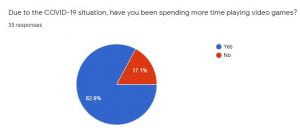Oh, how time flies. Look’s like this would be my last post (or will it?) for this blog!
To wrap things up, today we’ll be looking at one of the long-standing issues with video games (and other forms of digital media), being nature deficit disorder.
First introduced in 2005 by Richard Louv, the term refers to our increasing disconnection with nature due to prolific urbanisation and increasing development and use of electronic devices, among other things. Clearly, you can see how video games come into play here. I mean a simple google search for “video games and nature deficit disorder” would bring up results about saving children from the clutches of video games.

Although not just the fault of video games, with its rising popularity especially with the event of COVID-19, where video game sales in August for the US alone grew by 37%, I can see why the video game industry, in particular, is under so much fire. While I do agree that the idea behind the disorder does hold weight because the time spent playing games indoors could alternatively be spent on taking a walk in the park, I think it’s not as serious a problem today as compared to the past.
Almost like a paradox, the very video games which promote the disorder could be the ones to correct it after all. While yes, the effectiveness is yet to be determined, the potential is there nonetheless and a lot of it is attributed to gamification. By using video games as a proxy to convey environmental messages, the recipients could be more receptive because the mode of learning is viewed as more fun and enjoyable. Ideally, if done well, the user would not even notice that they are meant to “learn something” as the experience is so enjoyable.
Plus, this is definitely achievable. Look back to the previous post on VR, where its capabilities are already being harnessed to develop conservation-themed games. While options are few, they offer us a glimpse of the possibilities of future VR games, which could potentially be applied in schools for education.
Outside of VR, efforts are also being made to develop sustainability-themed games such as Plasticity, and Eco (multiplayer survival game), showing the gaming industry’s willingness to help work towards a greener future, on top of pledging to fight climate change.
All in all, since it looks like the end is not nigh for video games, as the saying goes: if you can’t beat them, join them.
Ideally, in a perfect world, everyone would not be glued to their screens and would be out frolicking in nature instead. However, as the technology industry and video games don’t look like they’ll slow down anytime soon, we might as well make the best out of it and harness it to experience the joys of nature (or the consequences due to the lack thereof) instead. But virtually!
Till next time (maybe)!
Cheers,
Tricia






